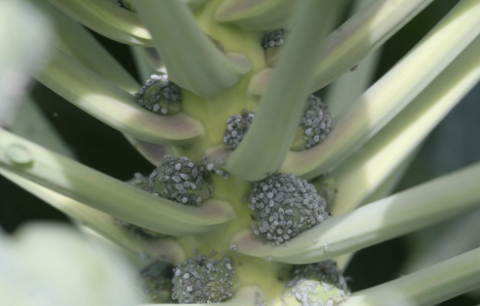Start scouting now for cabbage aphid

Those who grow crops in the Brassica family are likely familiar with the cabbage aphid, Brevicoryne brassicae, sometimes referred to by growers as “gray aphid”. It is often a significant problem on fall brassica crops, especially Brussels sprout, kale, and broccoli. In recent years, many growers in northern New England have reported increasing crop losses caused by this pest, mostly on late fall brassicas. The earliest aphids are usually found in early summer; we have already observed the first cabbage aphids on young broccoli and cabbage plants in southern NH this year.
Cabbage aphids have a distinctive whitish-gray appearance because they are covered with a white powdery wax coating. They are often found in thick clumps or colonies, feeding on the youngest tissue of Brussels sprouts, cabbage, broccoli, kale, and other members of the cabbage family.
Cabbage aphids overwinter as eggs laid on Brassica crops and weeds in the fall. The eggs hatch in early spring, giving rise to females that feed and produce live offspring. Winged aphids form after the initial infestations, and then fly to colonize new crops. In warmer climates, adults overwinter without producing eggs. It is possible that adults can overwinter in unheated high tunnels containing brassica crops here in the north. Some key cultural practices to manage cabbage aphid populations include destroying and burying brassica crop and weed residue in order to bury the eggs, managing brassica weeds (mustards, etc.), and rotating brassica crops away from where cabbage aphids were previously found.
Cabbage aphids are difficult to control if detected late in the season when populations are already very high. (It is also difficult to get insecticides to penetrate their thick colonies and into the crevices where they hide within the plant). Scout early and often, so that you know when they arrive. While the aphids themselves can be difficult to see, especially in small numbers, they produce a visible yellowing on the leaves. When you see this symptom as you walk the field, it is a good idea to examine plants more closely.

where cabbage aphids have been feeding.
When there are only a couple of infested plants, you can rogue or remove those plants, or possibly even mechanically destroy the initial aphids. Because the winged aphids are distributed randomly, it is important to scout thoroughly on a weekly basis. Economic thresholds suggest that you should treat if at least 10% of the plants are infested. You can also follow this UC Davis sequential sampling procedure, to reduce time spent scouting. Colleagues at UMass created a helpful Brassica scouting sheet, which helps you record the presence of all major brassica pests in one place.
Recent research by the UMass Extension Vegetable Program and at the NH Agricultural Experiment Station have shown that decent control of cabbage aphid using organically approved insecticides is possible, but that it requires a regular scouting regime and repeated applications (we have used up to 7-8 applications per season), increasing in frequency later in the season as aphid populations climb. There are also many conventional options, but timely application and rotation between insecticide options is key. In all cases, getting good coverage and use of appropriate spreader stickers (following label recommendations) is critical.
For additional information about this pest, see the following useful resources:
- University of California Pest Management Guidelines for Cabbage Aphid
- Cabbage Aphid. Within the New England Vegetable Management Guide.
